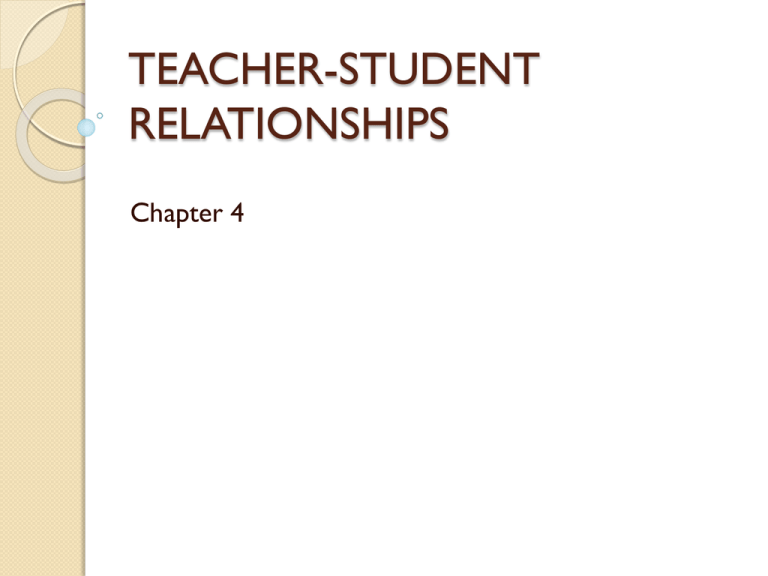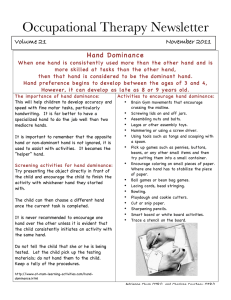TEACHER-STUDENT RELATIONSHIPS Chapter 4
advertisement

TEACHER-STUDENT RELATIONSHIPS Chapter 4 Teacher-student relationships are the keystone for most issues in the classroom. Without the foundation of a good relationship, students commonly resist rules and procedures along with the consequent disciplinary actions. Many problems can be avoided by better teacher-student relationships. Wubbels and Levy(1993) identify two dimensions whose interactions define the relationship between teacher and students. Dominance vs. Submission Cooperation vs. Submission 1. 2. Bottom line – the right combination of moderate to high dominance and moderate to high cooperation provides the optimal teacher-student relationship for learning. Figure 4.2(page 43) Wubbels(1999) – page 44 Chiu and Tulley(1997) – Optimal teacherstudent relationships consists of equal parts dominance and cooperation. Brophy and Evertson(1976) – page 44 Figure 4.4 – page 46 Between 12 and 22 percent of all children in school suffer from mental, emotional, or behavioral disorders, and relatively few receive mental health services. 40% of children are at risk of failure in school because of serious problems outside of school. School may be the only place where the needs of many of these children facing extreme challenges are addressed. Brophy(1996) – the most effective classroom managers tended to employ different strategies with different types of students. Effective classroom mangers do not treat all students the same, particularly in situations involving behavior problems. 1. Teacher Expectations and Student Achievement Program – Teachers should ensure that their behaviors are equal and equitable for all students, thus creating an atmosphere in which all students feel accepted. Response opportunities – equitable distribution of positive types of response, helping individual students, response latency, and types of questions. 2. 3. Feedback – affirmation of correct performance, praise and reasons for praise, listening, and accepting feelings. Personal Regard – addresses proximity, courtesy, personal interest, touching, and desisting. Action Steps 1. Use specific techniques to establish an appropriate level of dominance in the classroom. Balance those behaviors that communicate a proper level of dominance with those behaviors that communicate a proper level of cooperation. Once you have established and implemented rules and procedures as well as positive and negative consequences, you will have communicated your dominance. Two other areas are important to this communication: Exhibiting assertive behavior – ability to stand up for one’s legitimate rights in ways that make it less likely that others will ignore or circumvent them; “constructive assertiveness”. 1. a. b. Assertive body language – eye contact; erect posture; facing the offending student but keeping enough distance; facial expressions. Appropriate tone of voice – speaking clearly and deliberately; using pitch; avoid emotion in your voice. Vigenettes – page 50 Communication - Establish Clear Learning Goals Establish goals at the beginning of a unit Provide feedback on those goals Continually and systematically revisit the goals Summative feedback 2. Rubrics – page 51 Action Step 2. Use specific behaviors that communicate an appropriate level of cooperation Flexible learning goals Taking a personal interest in students Using equitable and positive classroom behaviors Responding appropriately to students’ incorrect responses Action Step 3 Be aware of the needs of different types of students Passive Aggressive Attention problems Perfectionist Socially inept Summary Communicate Special effort with some students – instruction, etc.


